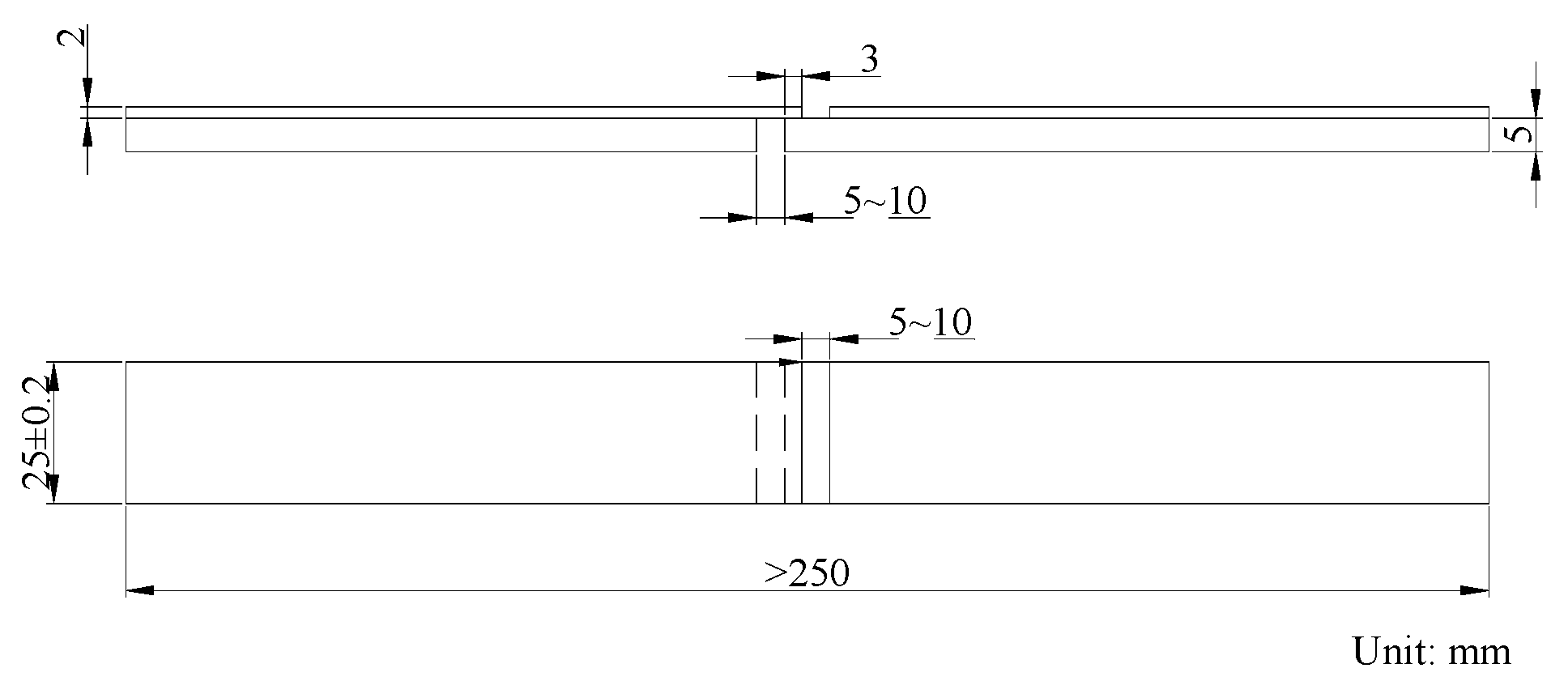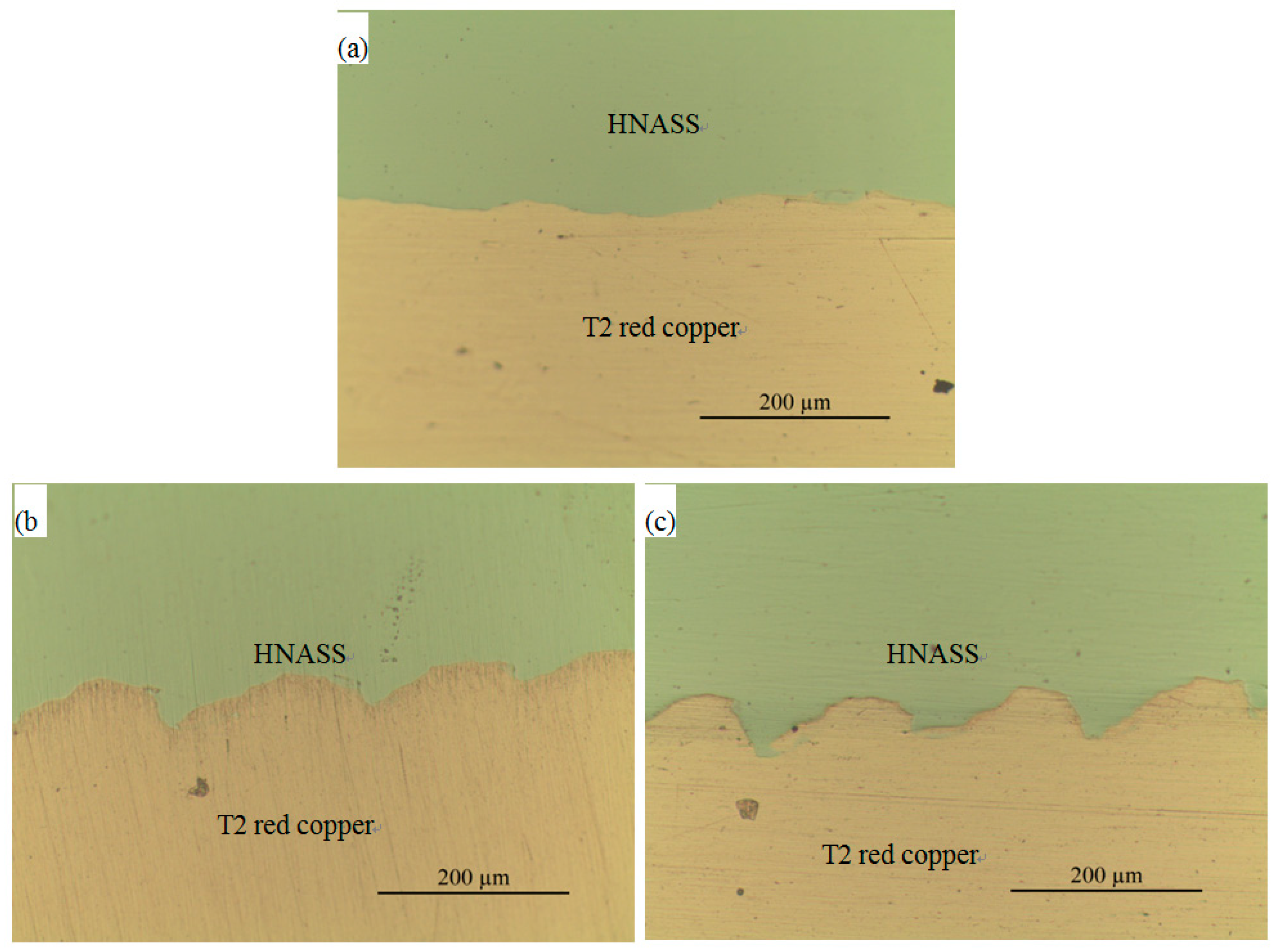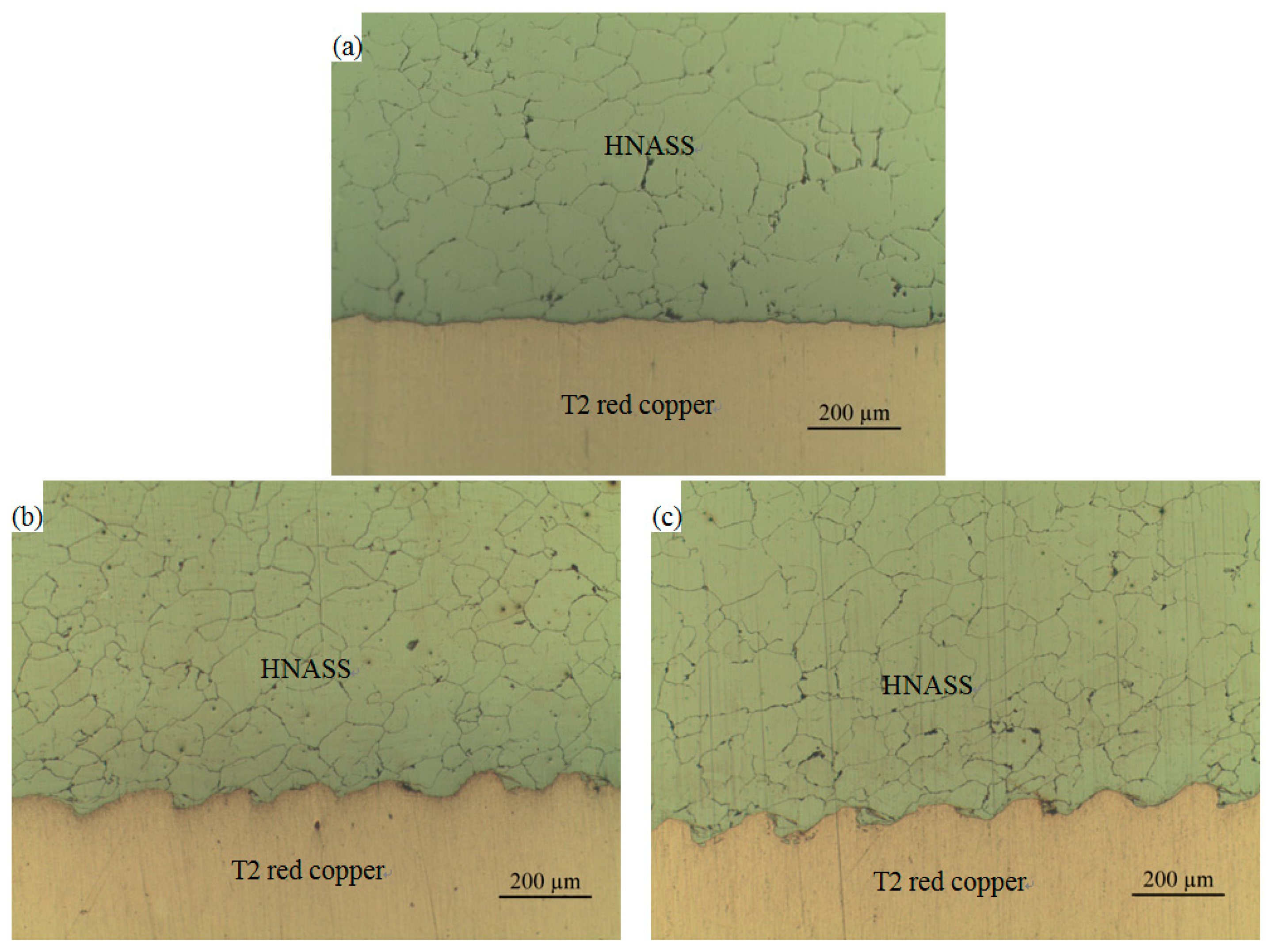Explosive Welding of Copper to High Nitrogen Austenitic Stainless Steel
Abstract
:1. Introduction
2. Weldability Window Calculations
3. Materials and Methods
4. Results and Discussion
4.1. Morphology of the Joint Surface
4.2. EDS Analysis
4.3. Microhardness
4.4. Tensile Shear Test Result
5. Conclusions
- A T2 red copper/HNASS composite could be successfully obtained by the explosive welding method if the proper explosive welding parameters were adopted, and the lower boundary should be calculated considering the mechanical parameters of HNASS.
- The morphology of the joint surface is different under different explosive welding parameters, and regular wave bonding can occur for larger explosive ratio.
- Although the joint interface was different under different explosive welding conditions, no intermetallic compounds were generated near the joint interface under three conditions.
Author Contributions
Funding
Conflicts of Interest
References
- Zhang, H.; Jiao, K.X.; Zhang, J.L.; Li, J. Microstructure and mechanical properties investigations of copper-steel composite fabricated by explosive welding. Mater. Sci. Eng. A Struct. Mater. Prop. Microstruct. Process. 2018, 731, 278–287. [Google Scholar] [CrossRef]
- Shi, F.; Cui, W.; Wang, L.; Jiang, Z.; Liu, C. Advance in the research of high-nitrogen austenitic stainless steels. Shanghai Met. 2006, 28, 45–50. (In Chinese) [Google Scholar]
- Lazurenko, D.V.; Bataev, I.A.; Mali, V.I.; Jorge, A.M., Jr.; Stark, A.; Pyczak, F.; Ogneva, T.S.; Maliutina, I.N. Synthesis of metal-intermetallic laminate (mil) composites with modified al3ti structure and in situ synchrotron x-ray diffraction analysis of sintering process. Mater. Des. 2018, 151, 8–16. [Google Scholar] [CrossRef]
- Bina, M.H.; Dehghani, F.; Salimi, M. Effect of heat treatment on bonding interface in explosive welded copper/stainless steel. Mater. Des. 2013, 45, 504–509. [Google Scholar] [CrossRef]
- Miao, G.; Ma, H.; Shen, Z.; Yu, Y. Research on honeycomb structure explosives and double sided explosive cladding. Mater. Des. 2014, 63, 538–543. [Google Scholar] [CrossRef]
- Athar, M.M.H.; Tolaminejad, B. Weldability window and the effect of interface morphology on the properties of al/cu/al laminated composites fabricated by explosive welding. Mater. Des. 2015, 86, 516–525. [Google Scholar] [CrossRef]
- Mousavi, S.A.A.A.; Sartangi, P.F. Experimental investigation of explosive welding of cp-titanium/aisi 304 stainless steel. Mater. Des. 2009, 30, 459–468. [Google Scholar] [CrossRef]
- Durgutlu, A.; Okuyucu, H.; Gulenc, B. Investigation of effect of the stand-off distance on interface characteristics of explosively welded copper and stainless steel. Mater. Des. 2008, 29, 1480–1484. [Google Scholar] [CrossRef]
- Cowan, G.R.; Bergmann, O.R.; Holtzman, A.H. Mechanism of bond zone wave formation in explosion-clad metals. Metall. Mater. Trans. B 1971, 2, 3145–3155. [Google Scholar] [CrossRef]
- Mousavi, A.A.A.; Al-Hassani, S.T.S. Numerical and experimental studies of the mechanism of the wavy interface formations in explosive/impact welding. J. Mech. Phys. Solids 2005, 53, 2501–2528. [Google Scholar]
- Carpenter, S.H.; Wittman, R.H. Explosion welding. Ann. Rev. Mater. Res. 1975, 5, 177–199. [Google Scholar] [CrossRef]
- Deribas, A. Physics of Hardening and Welding by Explosion; Nauka: Novosibirsk, Russia, 1972. [Google Scholar]
- Zheng, Z. Explosive Working; National Defense Industry Press: Beijing, China, 1981. [Google Scholar]
- Zakharenko, I.D.; Zlobin, B.S. Effect of the hardness of welded materials on the position of the lower limit of explosive welding. Combust. Explos. Shock Waves 1983, 19, 689–692. [Google Scholar] [CrossRef]
- Sun, T.-E.C. Explosion Physics; Science Press: Beijing, China, 2011. [Google Scholar]
- Zamani, E.; Liaghat, G.H. Explosive welding of stainless steel–carbon steel coaxial pipes. J. Mater. Sci. 2012, 47, 685–695. [Google Scholar] [CrossRef]
- Lysak, V.I.; Kuzmin, S.V. Lower boundary in metal explosive welding. Evolution of ideas. J. Mater. Process. Technol. 2012, 212, 150–156. [Google Scholar] [CrossRef]
- de Rosset, W.S. Analysis of explosive bonding parameters. Mater. Manuf. Process. 2006, 21, 634–638. [Google Scholar] [CrossRef]
- Walsh, J.M.; Shreffler, R.G.; Willig, F.J. Limiting conditions for jet formation in high velocity collisions. J. Appl. Phys. 1953, 24, 349–359. [Google Scholar] [CrossRef]
- Loureiro, A.; Mendes, R.; Ribeiro, J.B.; Leal, R.M.; Galvao, I. Effect of explosive mixture on quality of explosive welds of copper to aluminium. Mater. Des. 2016, 95, 256–267. [Google Scholar] [CrossRef]
- Kacar, R.; Acarer, M. An investigation on the explosive cladding of 316l stainless steel-din-p355gh steel. J. Mater. Process. Technol. 2004, 152, 91–96. [Google Scholar] [CrossRef]
- Kaya, Y.; Kahraman, N. An investigation into the explosive welding/cladding of grade a ship steel/aisi 316l austenitic stainless steel. Mater. Des. 2013, 52, 367–372. [Google Scholar] [CrossRef]








| Materials | ρ (g·cm−3) | Hv (HV) | σb (MPa) | Cb (m/s) | Tm (K) | K (W·m−1·K−1) | Cp (J·kg−1·K−1) |
|---|---|---|---|---|---|---|---|
| T2 red copper | 8.93 | 56 | 232 | 4730 | 1135 | 402 | 381 |
| HNASS | 7.82 | 320 | 1130 | 4600 | 1725 | 17 | 470 |
| Element Name | N | C | Mn | Ni | Cr | Mo | Cu | W | Fe | Sb | Bi | As | Pb | S |
|---|---|---|---|---|---|---|---|---|---|---|---|---|---|---|
| T2 red copper | -- | -- | -- | -- | -- | -- | Bal. | -- | 0.005 | 0.002 | 0.001 | 0.002 | 0.005 | 0.005 |
| HNASS | 0.88 | 0.03 | 19.28 | 2.01 | 19.32 | 0.0001 | 0.031 | 0.005 | Bal. | -- | -- | -- | -- | -- |
| Number | Stand-off Distance (mm) | Detonation Velocity (m/s) | Impact Velocity (m/s) | Collision Angle β (°) | Explosive Ratio R | Charge Depth (mm) |
|---|---|---|---|---|---|---|
| TH-1 | 6 | 2550 | 400 | 9 | 0.6 | 13 |
| TH-2 | 6 | 2550 | 533 | 12 | 0.9 | 20 |
| TH-3 | 6 | 2550 | 622 | 14 | 1.1 | 24 |
| TH-4 | 6 | 2550 | 798 | 18 | 1.6 | 36 |
| Explosive Ratios | R = 0.9 | R = 1.1 | R = 1.6 |
|---|---|---|---|
| Tensile strength (MPa) | 258 | 295 | 310 |
| Ruptured material | T2 red copper | T2 red copper | T2 red copper |
© 2019 by the authors. Licensee MDPI, Basel, Switzerland. This article is an open access article distributed under the terms and conditions of the Creative Commons Attribution (CC BY) license (http://creativecommons.org/licenses/by/4.0/).
Share and Cite
Liu, Y.; Li, C.; Hu, X.; Yin, C.; Liu, T. Explosive Welding of Copper to High Nitrogen Austenitic Stainless Steel. Metals 2019, 9, 339. https://doi.org/10.3390/met9030339
Liu Y, Li C, Hu X, Yin C, Liu T. Explosive Welding of Copper to High Nitrogen Austenitic Stainless Steel. Metals. 2019; 9(3):339. https://doi.org/10.3390/met9030339
Chicago/Turabian StyleLiu, Yingbin, Chao Li, Xiaoyan Hu, Chufan Yin, and Tiansheng Liu. 2019. "Explosive Welding of Copper to High Nitrogen Austenitic Stainless Steel" Metals 9, no. 3: 339. https://doi.org/10.3390/met9030339





